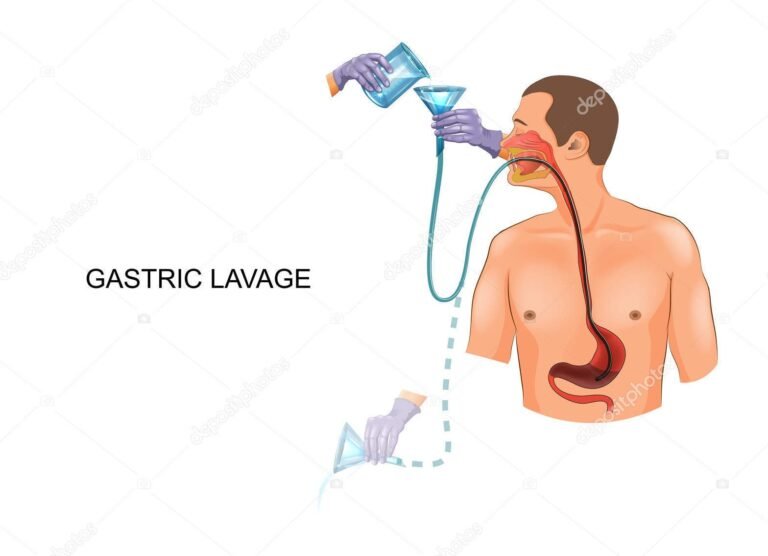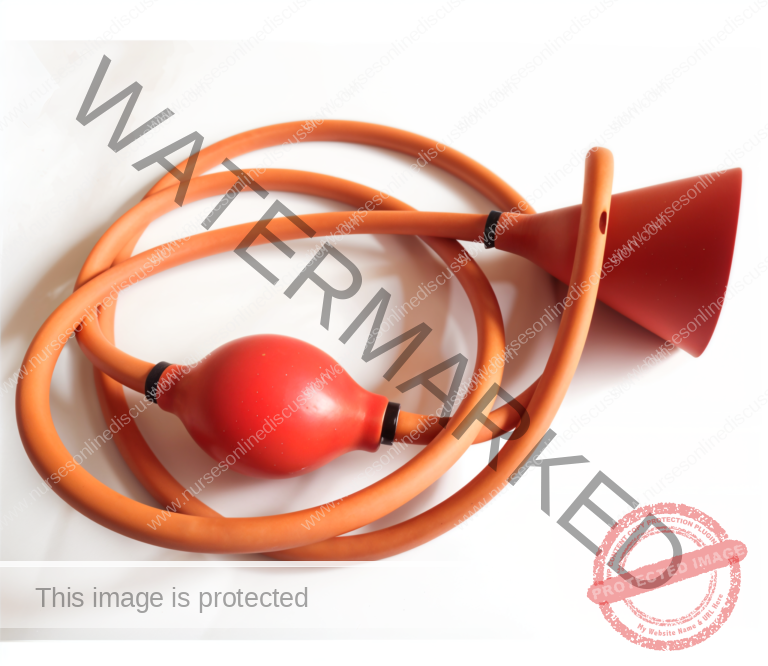Specialized Nursing Care Procedure
Subtopic:
Gastric Lavage

Learning Objectives
Define gastric lavage and explain its purpose as a gastrointestinal decontamination method.
Identify clinical indications and scenarios where gastric lavage is appropriate.
Recognize contraindications and safety concerns associated with the procedure.
List required equipment and setup steps for performing gastric lavage.
Describe the detailed step-by-step procedure for administering gastric lavage.
Gastric Lavage
- Gastric Lavage: Stomach Cleaning Process
- Gastric lavage is a method to cleanse the stomach contents.
Definition:
Gastric lavage is a gastrointestinal decontamination technique. It involves repeatedly introducing and removing small amounts of fluid into the stomach via a tube inserted through the nose or mouth (nasogastric or orogastric tube). This procedure aims to eliminate toxic substances from the stomach. Essentially, it’s a stomach washout using a tube.
Purpose of Lavage
Lavage is performed to:
Cleanse the stomach: For instance, after ingesting poison or overdosing on medication.
Manage GI bleeding: To help control gastrointestinal hemorrhage.
If a patient doesn’t already have a nasogastric tube, a doctor will order the insertion of a suitable tube before lavage.
Indications for Gastric Lavage:
Toxic Substance Ingestion: To remove harmful or poisonous substances from the stomach before they are absorbed into the body.
Pre-Endoscopy Preparation: To clear stomach contents before upper endoscopy, improving visualization during the procedure.
Stomach Acid Collection: To obtain stomach acid samples for diagnostic tests.
Gastric Pressure Relief: To reduce pressure in the stomach caused by blockages in the stomach or nearby digestive tract, alleviating discomfort and preventing complications.
Sputum Collection in Children: To collect sputum samples from children unable to cough it up, particularly for suspected pulmonary tuberculosis.
Cooling in Hyperthermia: As a cooling method for patients with high body temperature, using cool fluid irrigation to lower body temperature.
Gastric Hemorrhage Diagnosis: As a diagnostic tool for inflammatory conditions like gastric bleeding, by examining lavage fluid for signs and severity of hemorrhage.
Poisoning Cases: Frequently used in poisoning situations, especially when severe or patient history is unknown, to eliminate toxins and decrease poison absorption.
Specific Ingested Substances: Including:
Life-threatening substances: e.g., chloroquine, tricyclic antidepressants like amitriptyline or imipramine.
Non-absorbable substances in large quantities: e.g., iron, lithium.
Bezoar-forming substances: e.g., iron salicylates such as aspirin (acetylsalicylic acid). Bezoars are masses trapped in the digestive system.
Contraindications of Gastric Lavage:
Unconscious or Seizing Patients: Not suitable for comatose or convulsing patients.
Corrosive Substance Ingestion: Avoid if strong acids or alkalis were ingested, as it can worsen damage to the esophagus and stomach.
Large Pills: If ingested pills are too large to pass through the lavage tube.
Risk of Hemorrhage or Perforation: Not for patients with conditions predisposing them to bleeding or gastrointestinal rupture.
Hydrocarbon and Detergent Ingestion: Contraindicated for substances like ethanol (a hydrocarbon) and detergents.
Non-Toxic Poison: If the ingested poison is not harmful even at any dose.
Charcoal Adsorption Effective: If activated charcoal can effectively absorb the poison and the ingested amount is within charcoal’s capacity.
Late Presentation Post-Poisoning: May not be helpful if performed many hours after poisoning.
Effective Antidote Available: May be unnecessary if a highly effective antidote for the poison exists.
Complications of Gastric Lavage:
Increased Small Bowel Tablet Delivery: May push pills further into the small intestine, potentially increasing absorption.
Aspiration of Gastric Contents: Risk of stomach contents entering the lungs, leading to respiratory issues (occurs in roughly 3% of cases).
Esophageal Rupture: Rare, but a possible risk during the procedure.
Cardiac Issues: In certain poisonings (e.g., propranolol, calcium channel blockers), it can cause severe bradycardia, cardiac arrest, or asystole due to effects on heart function.
Nasal Trauma: Tube insertion can cause injury to the nasal passages.
Tracheal Intubation Need: May require intubation to protect the airway before lavage, especially if airway protection is compromised.
Electrolyte Imbalance and Hypothermia: Large fluid volumes can lead to electrolyte disturbances and decreased body temperature.

Procedure for Gastric Lavage
Requirements
Trolley Setup:
Top Shelf:
Rubber tubing
Stomach tube
Funnel
Bottom Shelf:
Mackintosh sheet and towel – To protect patient and bed linen.
Suction machine (if patient is unconscious) – To manage airway if needed.
Connector and clip
Receiver (container)
Bed Side:
Hand washing supplies – For hygiene.
2 Gallipots (small bowls)
Specimen jar – For stomach contents.
Screens – For privacy.
Bowl of swabs
Lubricant – To ease tube insertion.
Vomitus bowl
Adhesive tape – For securing tube if needed.
20 ml syringe – For aspiration.
Bucket – For collecting lavage fluid.
Litmus paper – To check stomach acidity.
3 receivers (containers)
Jar of water
Procedure for Gastric Lavage
Steps | Action | Rationale |
| 1. | General Preparation: Follow standard medical guidelines. Collect all required equipment and organize the trolley. Explain the procedure clearly to the patient. Ensure privacy by using screens and closing nearby windows. Position the trolley at the bedside. | To encourage patient collaboration. To uphold patient confidentiality. To minimize unnecessary movement during the procedure. |
| 2. | Waste Container: Place a bucket on the floor close to the bed. | To provide a receptacle for waste materials. |
| 3. | Patient Positioning: If conscious, request the patient to sit upright. If unconscious, position the patient on their side (prone or left lateral) and protect the patient and bed linen with a mackintosh sheet and towel around the neck and upper chest. | To safeguard bedding and patient clothing. To prevent aspiration in unconscious patients. |
| 4. | Funnel Connection: Connect the funnel to the tubing using a connector. Keep the stomach tube separate until insertion. | To prevent accidental fluid administration before tube placement. |
| 5. | Tube Lubrication & Insertion: Lubricate the tip of the stomach tube. Gently pass the tube over the tongue and into the pharynx, then the esophagus. | To facilitate smooth and comfortable tube passage. |
| 6. | Swallowing Encouragement: Continuously encourage the patient to swallow during tube insertion. | To aid in the advancement of the tube into the esophagus. |
| 7. | Stomach Content Aspiration: Attach the syringe to the tube and aspirate a small amount of stomach contents. | To verify correct placement of the tube within the stomach. |
| 8. | pH Testing: Test the aspirated stomach content with litmus paper. | To confirm gastric placement by checking for acidity. Stomach acid will turn blue litmus paper red. |
| 9. | Tube Clamping: Clamp the stomach tube with artery forceps and place the end in a receiver. | To prevent leakage or backflow of stomach contents. |
| 10. | Funnel Preparation: Apply a clip to the funnel and tubing assembly. Then, connect it to the already placed stomach tube. | To control fluid flow before commencing lavage. |
| 11. | Lavage Administration & Siphoning: Open the clip and gently introduce approximately 200-300 ml of lavage fluid into the funnel. Allow fluid to flow into the stomach until the level rises in the funnel. Then, invert the funnel downwards into the bucket to drain (siphon) stomach contents. Repeat this process until the returning fluid appears clear. Observe and note the characteristics of the stomach contents. | To effectively remove unwanted substances from the stomach. |
| 12. | Tube Removal: Clamp the stomach tube. Withdraw the tube smoothly and quickly from the stomach. Disconnect the tube from the funnel and tubing and place it in a receiver. | To minimize patient discomfort and potential trauma. |
| 13. | Patient Comfort: Offer the patient mouthwash. Thank the patient and clear away all used equipment. | To enhance patient comfort post-procedure. |
| 14. | Hygiene & Documentation: Wash your hands thoroughly. Document all relevant details including: (a) Type and volume of lavage solution used. (b) Appearance, odor, color, and quantity of gastric return. (c) Patient’s tolerance of the procedure. (d) Specimen handling and disposition. Clear away all remaining supplies. | For infection control and accurate record-keeping. Documentation is crucial for patient care and follow-up. |
Join Our WhatsApp Groups!
Are you a nursing or midwifery student looking for a space to connect, ask questions, share notes, and learn from peers?
Join our WhatsApp discussion groups today!
Join NowRelated Topics
Foundations of Nursing (III)
- Apply Nursing process to the management of patients
- Administer prescribed medicine appropriately
- Instilling medication (general)
- Blood transfusion
Specialized Nursing Care Procedures
- Perform Shortening and removal of drains
- Perform Colostomy Care
- Prepare Abdominis Paracentesis (Abdominal Tapping)
- Prepare Lumbar Puncture
- Perform Gastrostomy Feeding
- Carry out gastric Lavage
- Perform Tracheostomy Care
- Ophthalmological Care
- Care of the patient`s ears
- Pre-Operative Eye Care
- Ear Care
- Peri-Operative Care:
- Orthopedic Nursing Care
- Prepare for Neurological Assessment
Get in Touch
(+256) 790 036 252
(+256) 748 324 644
Info@nursesonlinediscussion.com
Kampala ,Uganda
© 2025 Nurses online discussion. All Rights Reserved Design & Developed by Opensigma.co

